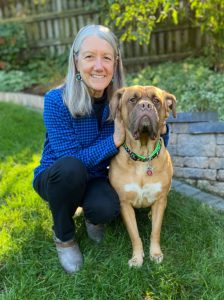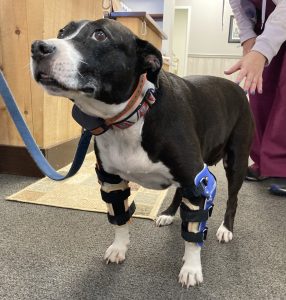
TERRY LACKMEYER
Customer Service Representative
Helping your once young dog cope with their senior years can be a challenging as well as a rewarding part of pet ownership. Senior dogs may move slower, but they still have plenty to offer especially when you know how to bring out the best in them. Most dogs are considered seniors by about age seven, smaller dogs a few years later and larger dogs a bit sooner, but seven is a good age to start being alert to changes in your pet.
Checking With Your Vet
A good place to start with your senior dog care is checking in with your veterinarian. If you have not had a blood panel done on your dog, this would be a good time to start, then have it done yearly. The vet will check numerous items, including white and red blood cell counts, kidney and liver function and sugar levels. Having a baseline status then makes it easier to note any alterations in your dog’s blood panel as the years progress. In some cases, senior dog pain relief may include medication from your vet, a weight loss regimen or physical therapy.
Controlling Weight
As dogs age they naturally slow down and become more sedentary. Overall, they don’t burn calories as well as they once did. It is particularly important now to watch that your dog does not put on excess weight. Any excess weight will put more stress on joints, aggravating any arthritis, as well as adding additional stress to major organs. Overweight dogs are more prone to life-threatening diseases like pancreatitis, diabetes, heart, liver and kidney disease. Now may be a good time to investigate switching your dog to a senior dog diet, which is higher in fiber and lower in calories.
While your dog may be slowing down, it is still important that they get regular exercise. The saying, “Use it or loss it” applies now more than ever. If you let your dog lay around and become a couch potato, they will begin to lose muscle mass and loss of muscle mass is what causes frailty, plus muscles burn more calories. Keep in mind, your dog does not need the massive amount of exercise they did in their youth, but they do need to move regularly. Movement keeps joints lubricated and helps to prevent stiffening. Several short walks throughout the day will be more beneficial than one long walk. The walks will not only stimulate their muscles, but their mind as well.
Deteriorating Senses
As dogs age, keep in mind that their internal thermostat doesn’t work as well as it once did. They become much more susceptible to temperature fluctuations and tend to mind the cold and heat more than they did in their younger days. When walking in the colder months, be sure to provide your dog with a cozy sweater or warm fleecy coat. In the warmer months, be sure to only walk your dog during the cooler times of day – early morning or late evening. If your dog enjoys being out in the yard, be sure they are not out too long and watch them closely for any signs of cold or heat sensitivity.
Like us, dogs tend to develop impaired hearing and vision as they age. If your dog seems to ignore you when you call or talk to them, it’s likely they may not be hearing you. Be sure to speak louder when talking to them or try clapping your hands initially to get their attention. Their vision may be deteriorating as well, so don’t expect them to maneuver easily in the dark. Placing night lights in rooms and hallways will help them to get around safely during the night. Keeping clutter out of pathways will help to prevent them from tripping. Be sure to block off dangerous areas, such as steps, so that they do not accidentally tumble down the stairs during the night.
Helping Achy Joints & Canine Arthritis
Arthritis is very common in older dogs, so doing things to help those achy joints will make your pet more comfortable. There are several different treatments for arthritis in dogs. Speak with your vet about adding joint supplements to their diet. Invest in a well-made orthopedic bed. All that extra padding will go a long way in keeping your dog more comfortable and some of them are even heated! Elevating your pet’s food and water dishes will make mealtimes easier, too. In severe cases, custom leg braces can ease pain by limiting motion at the joint.
If your dog is quite stiff and painful, discuss with your vet the possibility of physical therapy. Laser therapy is beneficial for both acute and chronic injuries as well as arthritis and muscle pulls. Hydrotherapy is great for building cardiovascular strength and the warm water helps to ease achy muscles and joints, without stressing the joints. Even dogs that don’t like water, tend to enjoy underwater treadmill work. Acupuncture also is helpful for a myriad of issues including neurological disorders, musculoskeletal problems, respiratory and gastrointestinal ailments. It can even be used to stimulate appetite if your dog has become a picky eater. Your vet also may prescribe mild pain relievers to help with severe discomfort.
Those tile and hardwood floors that your dog once traversed easily may now present serious challenges for your senior pet. You may find their legs slide out from under them as they walk, or they may be hesitant to walk on these floors at all. Try putting down skid-proof throw rugs or getting inexpensive yoga mats to lay in the walkways of your home. Even if your dog still likes lying on the tile and hardwood, get thick mats to put on those floors and encourage them to lie on those – their joints will thank you. Better yet, add another orthopedic bed.
Controlling Accidents
As dogs age, they no longer have the same bladder and bowel control that they once had. Many dogs as they age are not even aware of their need to relieve themselves, so accidents may happen or become more frequent. Keep in mind, that your dog is not doing this on purpose. Help them by giving them more potty breaks and not leaving them penned up at home for such long periods of time. If you need to be away from home all day, hire a pet sitter to stop by to let Rover out. To make your life easier, invest in a good rug spot cleaning machine.
You may find your senior dog just standing and staring into space. They may appear confused or not sure of where they are. They may have trouble navigating around furniture. People with whom they once were friendly may no longer seem to be recognized. Tricks that were once easy may seem to have been forgotten. You also may find that they wander around the house during the night instead of sleeping. If your dog exhibits these symptoms, they may be having cognitive issues similar to Alzheimer’s disease in humans. Have them checked by your veterinarian as there are medications that can help to lessen these symptoms.
Grooming Tips
Grooming may be different now that your dog is older. Have your groomer give a more hygienic clip to your dog’s private areas. If your dog has rear feathers, keeping those trimmed shorter will help to keep your dog from coming in the house with unwanted fecal matter attached to their coat. Nail clippings will probably need to be done more frequently. Since your dog is not as active and not walking as much, their nails are not wearing down. Long nails can cause your dog pain and make them reluctant to move around.
It is important to regularly run your hands all over your dog’s body to check for lumps, bumps, and growths. Be sure to check all areas – armpits, behind the ears, under the chin, belly, chest, and groin area. Being familiar with all the nuances of your dog’s body will enable you to notice that new lump or growth while it is still small. Small growths are much easier to treat or remove than large ones. While it may be nothing, that lump could be the start of a malignant growth, so the sooner it is discovered the easier it is to treat.
Closing Note
While senior dogs may not have the same boundless energy that they had in their youth, they still have plenty to give. Those old souls can still offer a lot of love and a tranquility that only comes with the wisdom of age. Helping your dog to navigate the trials and tribulations of their senior years will help to make their life easier. And, when you finally have to say those inevitable good-byes, as eventually we all must, you will be so happy that you did everything you could to give your dog a longer, more comfortable, and happier life.

